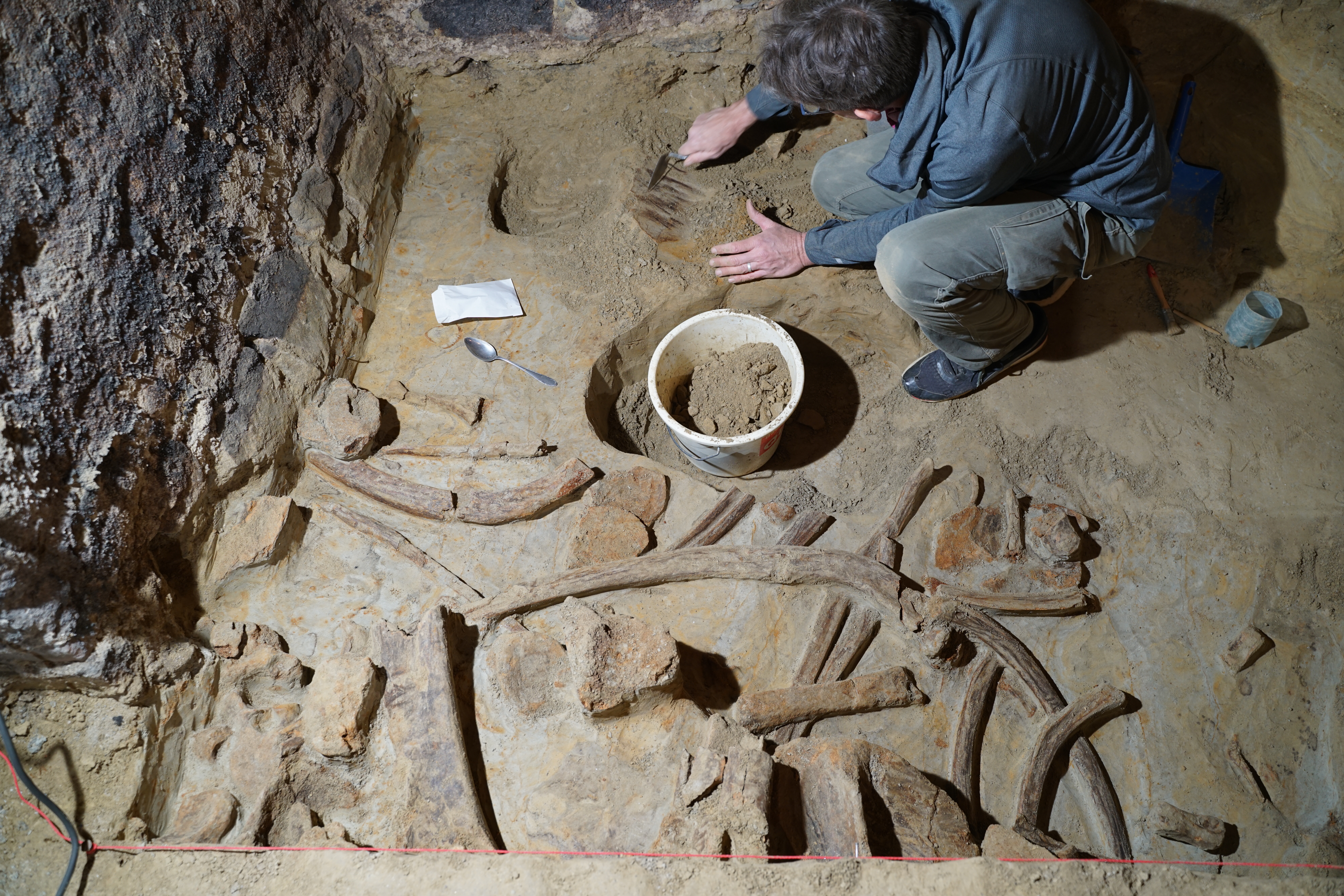Bones
Was This Giant, Armadillo-Like Animal Butchered by Humans in Argentina 21,000 Years Ago?
The creature's bones show evidence of cutting with stone tools, adding to a series of findings that suggest humans were present in the Americas earlier than thought
Did Plague Cause the Mysterious Collapse of Europe's Early Farmers 5,000 Years Ago?
A new study finds widespread DNA evidence that an ancestor pathogen of the Black Death helped bring about the end of an agricultural society responsible for megalithic tombs and monuments, like Stonehenge
Ancient Egyptian Scribes Were Worked to the Bone
The administrators spent long periods writing in odd postures, which damaged their joints, researchers discovered
Neanderthal Child May Have Had Down Syndrome, Fossil Suggests
The child's survival until at least 6 years old could be evidence of collaborative caregiving in Neanderthal societies, according to a new paper
16th-Century Skeletons of Children Infected With Smallpox Discovered in Peru
The toddlers' remains were buried around the beginning of the Spanish conquest of South America
Was This Mysterious Woman a Medieval Warrior?
Buried at a castle in Spain, the woman was found alongside the remains of 22 men who likely died on the battlefield
Oldest Wine Ever Found in Liquid Form Unearthed in 2,000-Year-Old Tomb
Researchers have concluded that the fluid preserved inside an ancient funerary urn is a white sherry-like wine
A Mass Grave of Maya Boys May Shed Light on Human Sacrifice in Chichén Itzá
Researchers have genetically tested the bones and made determinations of gender and family relations
These 28 Horses Were Buried in an Ancient Mass Grave. How Did They Die?
Archaeologists are puzzled by the 2,000-year-old burial site uncovered in central France
Austrian Man Discovers Hundreds of Mammoth Bones While Renovating His Wine Cellar
Owner Andreas Pernerstorfer thought he'd found a piece of wood, but then he remembered something his grandfather had said about finding teeth in the cellar decades ago
This 130,000-Year-Old Decorative Bear Bone May Be the Oldest Known Neanderthal Art
Researchers say the carved artifact was not a utilitarian item and instead served a symbolic purpose
These Ancient Skeletons Are Not Entwined Lovers, But a Daughter Embracing Her Mother
New research found that the two women, who were buried in Austria atop a horse, were first-degree relatives who died some 1,800 years ago
Meet Shanidar Z, a Neanderthal Woman Who Walked the Earth 75,000 Years Ago
After carefully piecing her skull back together, archaeologists and paleoartists have created a lifelike 3D reconstruction of the woman's face
Archaeologists Discover Medieval Artifacts Ahead of Bridge Demolition in England
Found during a construction project near the railway station in York, the trove includes pottery and bones
Could Running Around a 'Wall of Death' Help Astronauts Stay in Shape on the Moon?
Short sprints on these cylindrical structures, long used by daredevil motorcycle riders, might promote muscle mass and bone density in low-gravity conditions
In This Ancient Cemetery, Romans Left Fine Glass Vessels, Platforms for Feasting and Phallic Pendants
Archaeologists in Narbonne, France, have been studying the necropolis since 2017
These Massive, Extinct Salmon Had Spiky Teeth Like a Warthog's Tusks
For decades, scientists thought the teeth pointed downward, similar to those of a saber-toothed cat, but now they believe the fish's chompers jutted out sideways
Dentist Discovers Human-Like Jawbone and Teeth in a Floor Tile at His Parents' Home
Scientists are planning to study the specimen, embedded in travertine from western Turkey, in hopes of dating and identifying it
Did Ancient South Americans Keep Foxes as Pets?
At a cemetery in Argentina, a 1,500-year-old fox buried alongside humans suggests a "close relationship" between the species, researchers say
Vikings May Have Used Body Modification as a 'Sign of Identification'
A recent study analyzes Scandinavian examples of filed teeth and elongated skulls dating to the Viking Age
Page 1 of 14
:focal(1824x1372:1825x1373)/https://tf-cmsv2-smithsonianmag-media.s3.amazonaws.com/filer_public/01/b5/01b5dcee-a63d-4795-93fa-19327de9a2a4/esclerocalipto.jpg)
:focal(992x746:993x747)/https://tf-cmsv2-smithsonianmag-media.s3.amazonaws.com/filer_public/17/7d/177d0b16-2801-4319-8382-bd55829a1335/the-plague-may-have-ca-2.jpg)
:focal(504x379:505x380)/https://tf-cmsv2-smithsonianmag-media.s3.amazonaws.com/filer_public/a1/47/a1471e67-3144-4fd6-b09d-37eb8b4e1287/449285360_1037209888406935_5373426111682703336_n.jpeg)
:focal(2254x1503:2255x1504)/https://tf-cmsv2-smithsonianmag-media.s3.amazonaws.com/filer_public/ad/5d/ad5da0e9-e935-42bd-b02c-1bacd6410258/gettyimages-1294965819.jpg)
:focal(543x395:544x396)/https://tf-cmsv2-smithsonianmag-media.s3.amazonaws.com/filer_public/15/19/1519f6aa-9212-4342-b62a-630851fed78a/figura_281_2.jpeg)
:focal(812x541:813x542)/https://tf-cmsv2-smithsonianmag-media.s3.amazonaws.com/filer_public/61/fb/61fbc48a-3083-4b26-90ba-7cdc5bda46c5/1624px-alcazaba_de_zorita_01.jpg)
:focal(591x444:592x445)/https://tf-cmsv2-smithsonianmag-media.s3.amazonaws.com/filer_public/31/9f/319fffc0-0e81-407e-aac3-56b078c9970b/1-s20-s2352409x24002645-ga1_lrg.jpeg)
:focal(578x435:579x436)/https://tf-cmsv2-smithsonianmag-media.s3.amazonaws.com/filer_public/b1/fa/b1fa50a2-02cd-434a-8a53-3398312b5c14/original.jpeg)
:focal(1315x989:1316x990)/https://tf-cmsv2-smithsonianmag-media.s3.amazonaws.com/filer_public/e3/32/e3321938-85a1-4df5-b668-f096d85084d7/c_francois_goulin_inrap_-_capture_decran_2024-04-04_a_114125-min.jpeg)

:focal(400x370:401x371)/https://tf-cmsv2-smithsonianmag-media.s3.amazonaws.com/filer_public/39/f3/39f37776-f960-42a6-95c8-ff3289985870/bear_bone_resize_2.jpg)
:focal(1000x752:1001x753)/https://tf-cmsv2-smithsonianmag-media.s3.amazonaws.com/filer_public/86/a1/86a1db67-c6f2-47c7-9b31-1042351b6646/burial.jpg)
:focal(4096x2750:4097x2751)/https://tf-cmsv2-smithsonianmag-media.s3.amazonaws.com/filer_public/36/ba/36ba428b-e327-41b9-a50c-3a8cbdd38649/cambridge_5.jpg)
:focal(557x419:558x420)/https://tf-cmsv2-smithsonianmag-media.s3.amazonaws.com/filer_public/3c/7c/3c7c5346-65a1-4dad-9b4b-54349d55b8b9/york-station-03-min.jpeg)
:focal(964x726:965x727)/https://tf-cmsv2-smithsonianmag-media.s3.amazonaws.com/filer_public/91/83/9183dc9b-7d7d-45f2-8b30-dae3edd7fb45/rsos231906f003.jpg)
:focal(854x642:855x643)/https://tf-cmsv2-smithsonianmag-media.s3.amazonaws.com/filer_public/6a/8f/6a8fc109-1a67-4aed-9d54-50bfb1d85a3d/dsc1945.jpeg)
:focal(593x507:594x508)/https://tf-cmsv2-smithsonianmag-media.s3.amazonaws.com/filer_public/fb/4f/fb4fa92d-5623-4ba5-b7cb-9e3402486a48/spike_tooth_profile_press_ray_troll.jpg)
:focal(540x360:541x361)/https://tf-cmsv2-smithsonianmag-media.s3.amazonaws.com/filer_public/05/c5/05c5b0c8-2e9b-410e-bd2b-44fa17b8eaaf/found-a-mandible-in-the-travertin-floor-at-my-parents-house-v0-6rxgyqsizluc1.jpeg)
:focal(600x451:601x452)/https://tf-cmsv2-smithsonianmag-media.s3.amazonaws.com/filer_public/74/2c/742c5a06-45ab-4f31-b257-c71a1dd49501/dusicyon_avus_wikipedia_juandertal_1.jpeg)
:focal(1000x752:1001x753)/https://tf-cmsv2-smithsonianmag-media.s3.amazonaws.com/filer_public/56/aa/56aa76a2-51d9-4af2-82a8-79c9f6bb873d/viking.jpg)